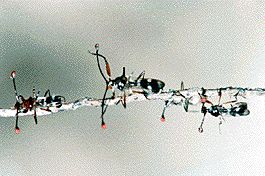Allometry

Allometry is an important method for describing morphological evolution. It is the relation between the size of an organism and the size of any of its parts: for example, there is an allometric relation between brain size and body size, such that (in this case) animals with bigger bodies have bigger brains.
Allometric relations can be studied
• during the growth of a single organism;
• between different organisms within a species;
• between organisms in different species.
A typical allometric graph plots body size on the x-axis and some other character, such as brain, or eye-stalk, size on the y-axis.
The points on these graphs can be for
• the same individual measured at different ages;
• for different individuals of a species (in which case the scatter will mainly be due to variation in age);
• for different species in a higher taxon.
Developed by Huxley, this method works easily for two characters, but is clumsy for complex shapes. For complex shapes, D'Arcy Thompson's transformations can be more illuminating .
The image opposite is of stalk-eyed flies from Malaya, which have an eyespan longer than their body. There is an allometric relationship between eyespan and body length.
| Next |



